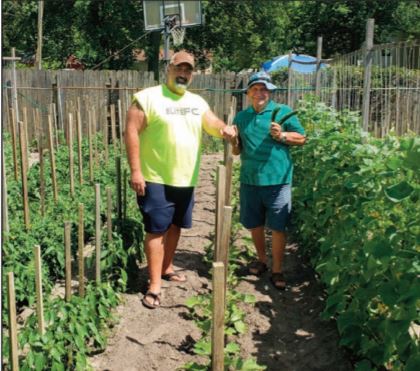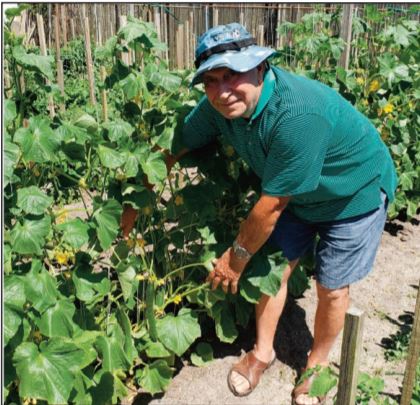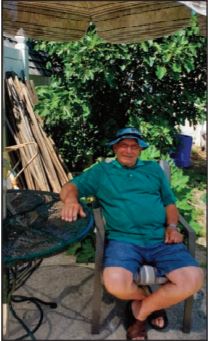
HAMMONTON—For the Catania family, Felice Catania’s garden is a long-standing tradition.
Catania’s son, Franco, said that his father has been growing produce for most of his life.
“He’s been farming since the age of 16 in Sicily, but in Sicily they did lemon trees and orange trees. He may be the only guy left in Hammonton who knows how to graft trees. In Italy, they would use the base of the lemon tree and graft an orange branch to it to make an orange tree, because the lemon tree is easily adapted to the ground in Sicily. When he came to the United States, he had a couple apartments, but when he bought this place he planted the garden. He’s been gardening this piece of ground since 1971,” Franco Catania said.
The garden, Franco Catania said, has several staple crops.
“In the garden, he grows peas, Swiss chard lettuces, fava beans, cucumbers—burpless ones—and there’s a few different varieties of tomatoes. The variety of plum tomatoes has almost no water in it; there’s a little bit of juice, but it’s not your typical plum when you cut it. That’s the secret to our sauce. We have a variety of that tomato, then he has beefsteak tomatoes,” he said.
“I had the seed to the yard beans that I brought over here in 1967. Every year I leave a piece to renew the seeds.”
Felice Catania
He also said that one of the secrets to the long-running success of the garden is that his father often makes his own seeds from the crops of previous years.
“He also has the Italian zucchini, cucuzza longa, or baseball bat squash. He still makes seed every year from that. There’s a couple of old-timers left who grow it, and there was a shortage of seeds so he ended up coming to the rescue with about 100 seeds to help some of these guys produce plants,” he said.
For that particular squash, Felice Catania said that there was a trick. “For the cucuzza longa, when it’s high, you’ve got to put a bucket of water underneath it. The cucuzza longa will grow down to it, and it can be more than five feet long,” he said.

Some of the seed pedigrees can be traced back to Catania’s arrival in the United States.
“I had the seed to the yard beans that I brought over here in 1967. Every year I leave a piece to renew the seeds,” Felice Catania said.
Franco Catania said that the yard beans were a common dish when he was growing up.
“When I was a kid, people asked how we ate those. My mother used to boil them and make pasta, so it looked like we had green and white linguini with tomato sauce,” he said.
Felice Catania went into a little bit of detail about how his wife, Rosaria, would prepare the meal.
“My wife would put it in the freezer, too, then break it before she boiled it. When it was cooked, she’d take it out and, in the same water, put spaghetti or linguini or whatever. When the pasta was cooked, take it out, mix it together and put the sauce in,” he said.
Another classic Sicilian dish made with the fruits of the Catania garden is stuffed zucchini flowers. For that, Rosaria herself gave the run-down on its preparation.
“The zucchini flower. I stuff it with mozzarella, then I put them in egg and then flour, and then I fry it,” she said.
Franco Catania said that one of the garden’s most long-standing features is its fig tree.
“In the garden, we have a fig tree that was brought here more than 40 years ago from Sicily. We got so intense in the ‘80s that we had a portable structure that we built around it. We put walls up, then we had electric with a floodlight flash on the tree. When the temperature would fall under 32 degrees, we would flip the switch and put the heat on it. As time went on, the structure would fall apart. The older we got, who’s in school, who’s not around and it got to be too much. Now we just wrap it,” he said.
“He has a 20-yard row of cucumbers. When he starts picking, he’ll be picking 20 to 25 cucumbers a day. What’s he going to do with all of them? What he does is the old Italian way: he gets a bag and drives to this one’s house, goes to that one’s house and puts it on the porch. ‘Hey, what’re you doing? What’s going on?’ Then somebody else will trade for some wine. That’s the old way.”
Franco Catania
Franco Catania noted that, although his father grows much more produce than he and Rosaria—and their family—could possibly eat, Felice Catania always finds something to do with the vegetables.
“He has a 20-yard row of cucumbers. When he starts picking, he’ll be picking 20 to 25 cucumbers a day. What’s he going to do with all of them? What he does is the old Italian way: he gets a bag and drives to this one’s house, goes to that one’s house and puts it on the porch. ‘Hey, what’re you doing? What’s going on?’ Then somebody else will trade for some wine. That’s the old way,” Franco Catania said.
He noted that his youngest daughter, Angelina, has a particular affinity for the garden—and her grandfather.
“Angelina’s named after his mother, and you can see the connection they have. She loves to farm. She loves all that stuff,” he said.
Felice Catania said that his granddaughter is particularly fond of the cucumbers he grows, even though this year’s crop was damaged by frost.
“Today, my granddaughter called. ‘Nonno, you have any more cucumbers?’ Yesterday she was here. They’re small right now, but I know she likes them, so I got two and she ate them. Today I said, ‘I don’t have cucumbers; if you want to come over, have lunch.’ ‘What are you having for lunch?’ ‘I’m not saying. You want to come over here, have lunch.’ So when she came for lunch, my wife made linguini with crab. She loved it. Then I got a couple of cucumbers and she ate them,” he said.
One of the secrets to Felice Catania’s gardening successes is the incorporation of traditional ways of farming that he learned in Sicily. Chief among them is how he irrigates the garden.
“A lot of people don’t understand, and they use sprinklers. But in this heat that’s no good. I have the rows over there, and I put the hose and it runs. For a couple of days, I don’t have to water,” he said.
Franco Catania explained further.
“He does a deep, deep soak as a canal. So he’ll start, beginning with a cup and the hose, and he lets it run. By the time it gets all the way to the end, it’s well-watered all the way through,” he said.
Felice Catania also said that he uses no chemicals or sprays on his crops. He keeps a decoy owl near the fig tree to chase away birds, and spreads coffee grinds to keep ants away.
Franco Catania noted that this type of self-sustaining gardening—harvesting seeds, no chemical usage and so forth—which has been a tradition in his family is once again starting to gain traction.
“I think you’re going to start seeing a trend, where some of the millennials and the younger people coming up are going to attempt to garden and become more self-sufficient,” he said.
Franco Catania said that, when he was a child, working in the garden would be an all-day affair. Now, Felice Catania can be found in the garden in the morning, or after 5 p.m., to avoid the hottest hours of the day.

Though Franco Catania offers to help as much as he can, he said that his father often insists on doing the work himself.
When he gets tired, or when he just wants to go outside and relax, Felice Catania said that he has the perfect setup right inside the garden.
“I have a table with an umbrella. When I want to take a rest, I stay over there, drink some wine and listen to music,” he said.
This story was produced in collaboration with CivicStory and the New Jersey Sustainability Reporting project. It was originally reported by Joseph F. Berenato for The Hammonton Gazette, and may be re-distributed through the Creative Commons License, with attribution.
